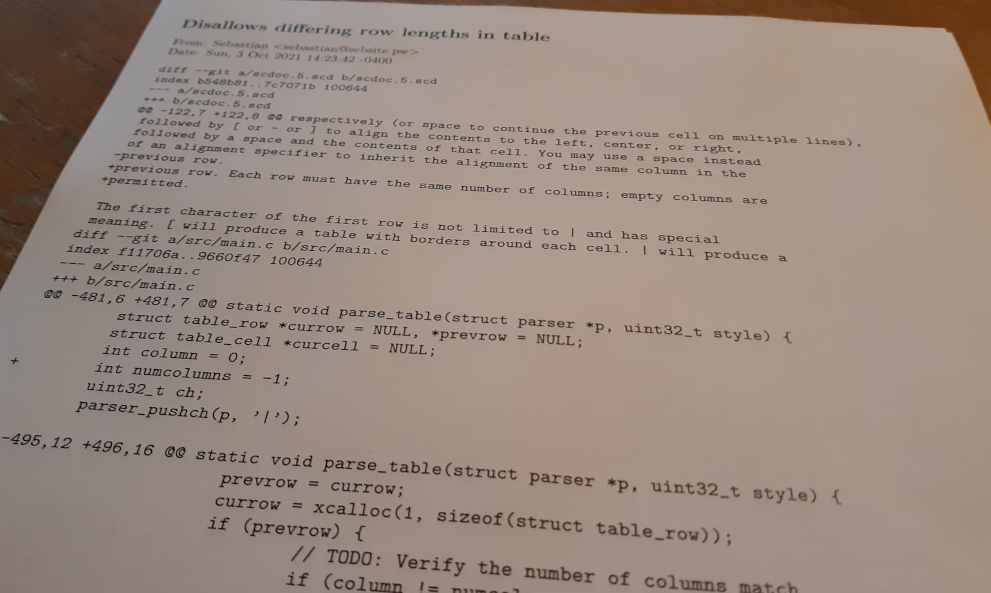

git snail-mail
source link: https://drewdevault.com/2022/04/01/git-snail-mail.html
Go to the source link to view the article. You can view the picture content, updated content and better typesetting reading experience. If the link is broken, please click the button below to view the snapshot at that time.
Announcing git snail-mail April 1, 2022 on Drew DeVault's blog
You’ve heard of git-over-email thanks to git send-email — now you can enjoy git snail-mail: a new tool making it easier than ever to print out git commits on paper and mail them to your maintainers.
Running
git snail-mail HEAD~2..prepares the last two commits for post and sends them directly to the system’s default printer. Configuration options are available for changing printer settings, paper size, and options for faxing or printing envelopes automatically addressed to the maintainers based on address info stored in your git config. Be sure to help the maintainers review your work by including a return envelope and a stamp!And for maintainers, code review has never been easier — just get out your red marker and write your feedback directly on the patch! When you’re ready to import the patch into your repository, just place it on your scanner and run
git scan-mail.

At least, this is what I’d like to say, but I ended up cancelling the project before it was ready for April Fool’s. After my friend kline (a staffer at Libera Chat) came up with this idea, I actually did write a lot of the code! Git is mostly written in Perl, but I could not really rouse the enthusiasm for implementing this idea in Perl. I did the prototype in $secretlang instead, and got it mostly working, but decided not to try to do some sneaky half-private joke release while trying to maintain the secrecy of the language.
Essentially how it works is this: I have a TeX template for patches:
\documentclass{article}
\usepackage[
a4paper,
top=1cm,
bottom=1cm,
left=1cm,
right=1cm,
]{geometry}
\usepackage{graphicx}
\usepackage{fancyvrb}
\pagenumbering{gobble}
\begin{document}
\section*{implement os::exec::peek\{,any\}}
From: Bor Grošelj Simić \textless{}[email protected]\textgreater{} \\
Date: Fri, 25 Feb 2022 01:46:13 +0100
\VerbatimInput{input.patch}
\newpage
Page 1 of 2 \\
\includegraphics[]{./output-1.png}
\newpage
Page 2 of 2 \\
\includegraphics[]{./output-2.png}
\end{document}
This is generated by my git snail-mail code and then run through pdflatex to produce a file like this. It pipes it into lp(1) to send it to your printer and ta-da!
I chose not to make the commit selection work like git send-email, because I think that’s one of the most confusing parts of git send-email. Instead I just use a standard revision selection, so to print a single commit, you just name it, and to print a range of commits you use “..”. Here’s a peek at how that works:
fn get_commits(
data: *texdata,
workdir: str,
range: str,
) (void | exec::error | exec::exit_status | io::error | fs::error) = {
const fmt = `--format=%H%x00%s%x00%aN%x00%aE%x00%aD`;
const pipe = exec::pipe();
const cmd = exec::cmd("git", "show", "-s", fmt, range)?;
exec::addfile(&cmd, os::stdout_file, pipe.1);
const proc = exec::start(&cmd)?;
io::close(pipe.1);
const pipe = pipe.0;
defer io::close(pipe);
static let buffer: [os::BUFSIZ]u8 = [0...];
const pipe = &bufio::buffered(pipe, buffer[..], []);
let path = path::init();
for (true) {
const line = match (bufio::scanline(pipe)?) {
case let line: []u8 =>
yield strings::fromutf8(line);
case io::EOF =>
break;
};
// XXX: This assumes git always does the thing
const tok = strings::tokenize(line, "\0");
let commit = commitdata {
sha = strings::next_token(&tok) as str,
subject = strings::next_token(&tok) as str,
author = strings::next_token(&tok) as str,
email = strings::next_token(&tok) as str,
date = strings::next_token(&tok) as str,
...
};
path::set(&path, workdir)!;
path::add(&path, commit.sha)!;
commit.diff = strings::dup(path::string(&path));
append(data.commits, commit);
const file = os::create(commit.diff, 0o644)?;
defer io::close(file);
const parent = strings::concat(commit.sha, "^");
defer free(parent);
const cmd = exec::cmd("git", "diff", parent, commit.sha)?;
exec::addfile(&cmd, os::stdout_file, file);
const proc = exec::start(&cmd)?;
const status = exec::wait(&proc)?;
exec::check(&status)?;
};
const status = exec::wait(&proc)?;
exec::check(&status)?;
};
The --format argument provided to git at the start here allows me to change
the format of git-show to use NUL delimited fields for easily picking out the
data I want. Point of note: this is minimum-effort coding for a joke, so there’s
a lot of missing error handling and other lazy design choices here.
Anyway, I would have liked to have rewritten this in Perl and pitched it to the git mailing list for inclusion upstream, but alas, after prototyping in $secretlang I could not bring myself to rewrite it in Perl, and the joke fell flat. Not every idea pans out, but they’re still worth trying, anyway. If you want to see some joke projects I’ve made that actually work, check these out:
- shit: a git implementation in POSIX shell
- bfbot: a working IRC bot written in brainfuck
- classic6: a working Minecraft server written in 6 hours
- evilpass: a password strength checker that detects password reuse
- tw: a Wayland compositor for your terminal in 80 lines of “code”
Take care!
Recommend
About Joyk
Aggregate valuable and interesting links.
Joyk means Joy of geeK